| Summary: What is a hazard and what is a risk? Explaining the 2 terms in context of oil and gas sector with examples here. By understanding these concepts, industry professionals can significantly enhance safety measures and minimize potential threats to both workers and the environment. |
The oil and gas sector, essential for global energy, is laden with hazards that endanger both workers and the environment. The hazards include physical threats like fires and explosions, chemical exposure to toxic substances, and ergonomic issues of repetitive movements. These dangers compromise worker safety, operational efficiency, and environmental well-being.
Let’s have a look into the hazards in oil and gas industry with its associated risks.
Hazard Vs Risk – The Major Differences
A hazard is a potential source of harm, such as flammable gases or toxic chemicals. Risk assesses the likelihood and severity of harm occurring from these hazards, such as the probability and impact of an explosion from a gas leak.
The below table provides a clear comparison between hazard and risk in the context of the oil and gas sector.
| Aspect | Hazard | Risk |
| Definition | A potential source of harm or adverse health effect | The likelihood of harm or adverse health effects occurring, combined with the severity |
| Nature | Intrinsic property or condition that can cause damage or harm | A function of the probability of a hazardous event and the severity of its consequences |
| Example | Flammable gases, high-pressure systems, toxic chemicals | Probability of an explosion from a gas leak and the potential severity of resulting injuries |
| Conceptual Focus | Potential for harm or damage | Probability and impact of harm or damage occurring |
| Quantification | Identified qualitatively | Quantified through risk assessment, considering both likelihood and severity |
| In Practice | Hazard Identification: Recognizing potential sources of harm | Risk Assessment: Evaluating hazards to determine risk level, analyzing likelihood and consequences |
Now let’s look into the various types of hazards and its associated risks in terms of various risk assessment procedures in the industry.
Common Hazards and Risks in the Oil and Gas Industry
1. Physical Hazards and Associated Risks
| Hazard | Risk |
|
|
Catastrophic fires and explosions can lead to severe injuries or fatalities, significant property damage, and operational disruptions. |
| Slips, Trips, and Falls | Workers face serious injuries such as fractures, sprains, and head injuries resulting from falls, especially on oil rigs and slippery surfaces. |
|
Heavy Machinery
|
Crush injuries, amputations, and fatalities if machinery is not properly handled or maintained. |
| Confined Spaces | Risk of suffocation, entrapment, or exposure to hazardous atmospheres |
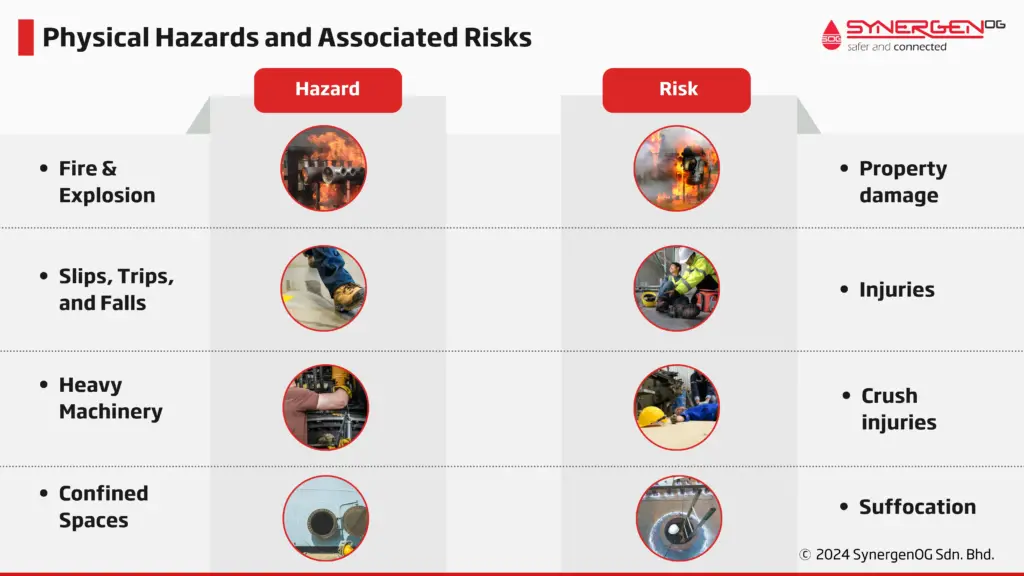
Example: The Deepwater Horizon explosion in 2010
Hazard: The primary hazard was the uncontrolled release of hydrocarbons that lead to a massive fire and subsequent explosion.
Impact of the associated risks:
- Severe injuries and fatalities
- Property damage
- Environmental damage
- Operational disruptions
- Legal and financial repercussions
2. Chemical Hazards and Associated Risks
| Hazard | Risk |
| Exposure to Hazardous Chemicals | Workers can suffer from health issues such as respiratory problems, skin conditions, and long-term chronic illnesses due to exposure to hazardous chemicals used in drilling and processing. |
| Leaks and Spills | Accidental leaks or spills of oil, gas, and chemicals can lead to environmental contamination, health risks to workers, and significant cleanup costs. |
| Inhalation of Toxic Gases | Immediate health risks, including asphyxiation, respiratory issues, and long-term health effects. |
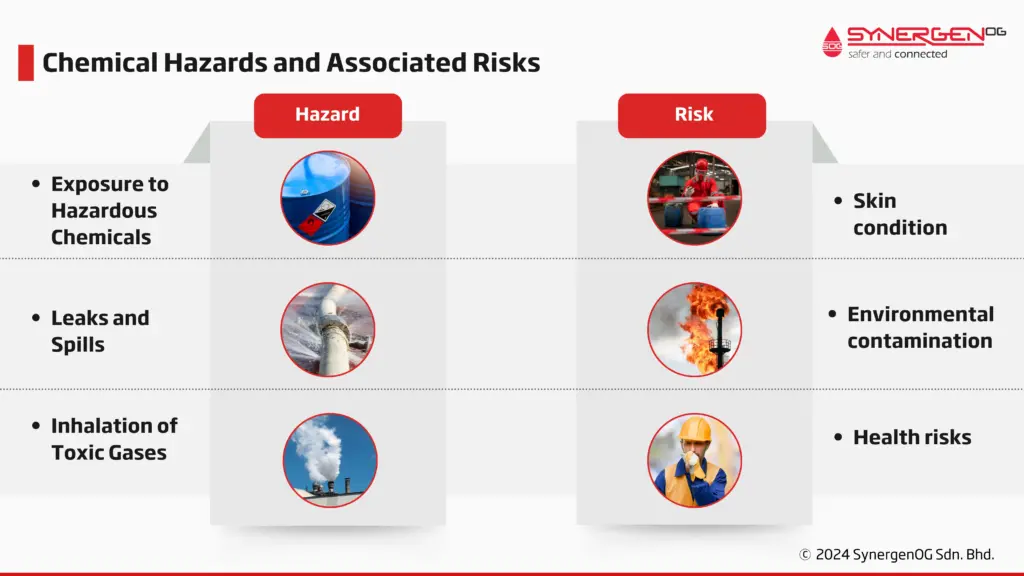
Example: Bhopal Gas Tragedy (1984)
Hazard: The primary hazard was the accidental release of toxic methyl isocyanate gas due to a storage tank malfunction.
Impact of the associated risks:
Severe health impacts, causing the deaths of over 3,000
- Long-term health effects including respiratory problems, eye irritation, and birth defects.
- Extensive contamination of the local environment, including soil and water sources
- Damage to the plant infrastructure and surrounding areas
- Union Carbide faced numerous lawsuits, substantial fines, and compensation claims.
3. Ergonomic Hazards and Associated Risks
| Hazard | Risk |
| Repetitive Motion | Repetitive strain injuries can occur due to repeated movements and awkward postures required in many oil and gas tasks, affecting productivity and worker health. |
| Musculoskeletal Strain | The physical demands of the job, including lifting heavy objects and working in confined spaces, can lead to musculoskeletal disorders over time. |
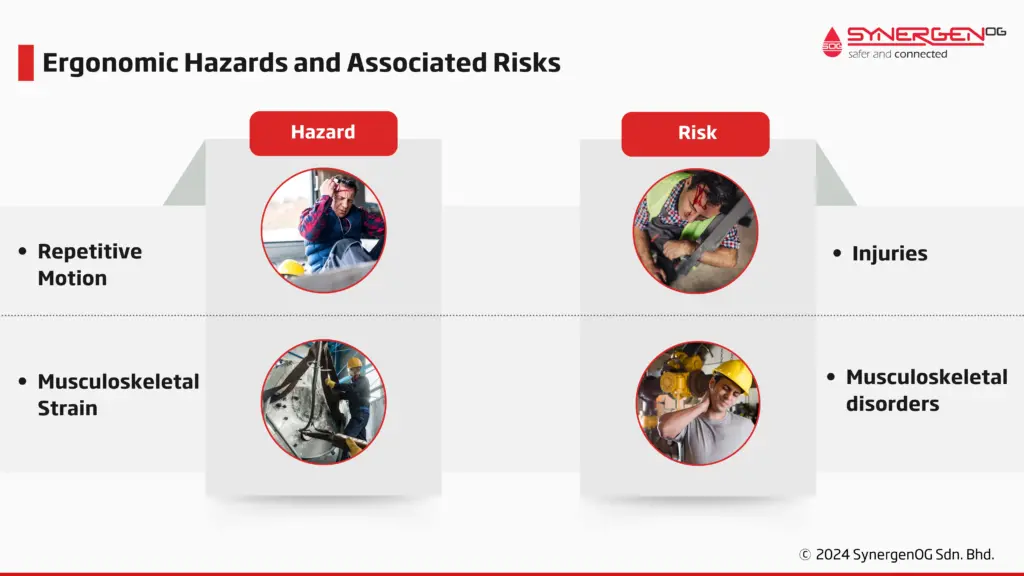
4. Psychosocial Hazards and Associated Risks
| Hazard | Risk |
| Stress | The high-pressure environment of the oil and gas industry, combined with long shifts and remote locations, can lead to significant mental health issues, reduced job performance, and increased likelihood of accidents. |
| Long Working Hours | Extended work hours and shift work can result in fatigue, reducing alertness and increasing the likelihood of accidents. |
| Remote and Harsh Working Conditions | Working in isolated and extreme environments can lead to mental health challenges, feelings of isolation, and reduced quality of life for workers. |
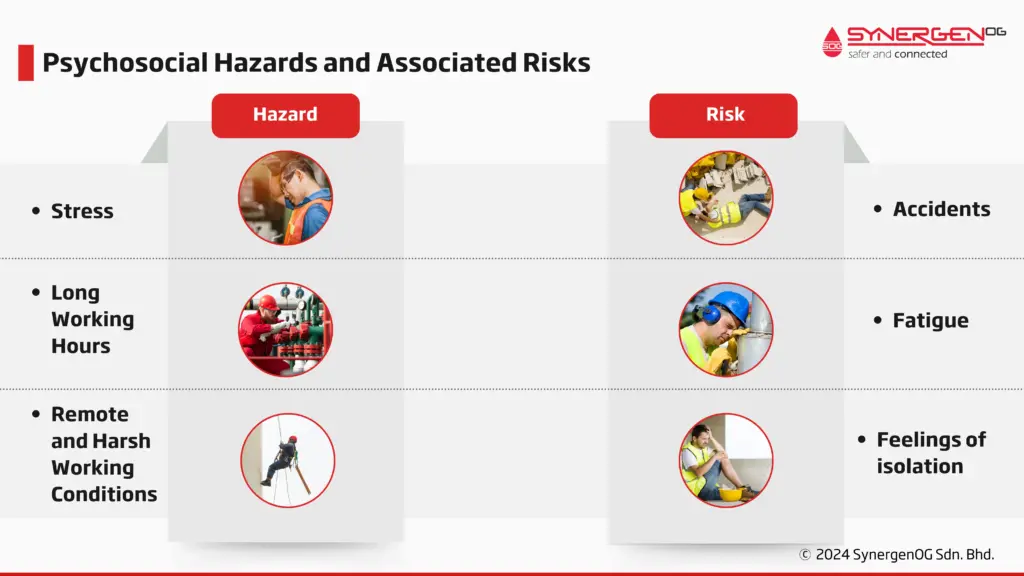
Need of Oil and Gas Safety Measures
In order to prevent accidents and ensure a safe working environment, comprehensive oil and gas safety measures are essential.
1. Personal Protective Equipment (PPE)
PPE is a critical component of oil and gas safety measures. Workers are equipped with gear such as helmets, gloves, and fire-resistant clothing to protect them from potential hazards. Proper use of PPE reduces the risk of injuries and fatalities in hazardous environments.
2. Safety Training and Drills
Regular safety training and emergency drills are essential for preparing workers to respond effectively to emergencies. Training ensures that workers are aware of the risks and know how to use safety equipment, while drills simulate emergency scenarios to improve response times and decision-making.
3. Regular Maintenance and Inspections
Consistent maintenance and inspections of equipment and facilities help prevent mechanical failures and accidents. Regular checks ensure that all safety systems are functioning correctly, reducing the likelihood of incidents related to equipment malfunction.
4. Emergency Response Plans
Having a well-defined emergency response plan is important in the oil and gas industry. These plans outline the procedures to follow in the event of an incident, ensuring that workers know their roles and responsibilities. Effective emergency response can minimize damage and save lives during critical situations.
Read: 14 Elements of Process Safety Management
Conclusion
Despite the inherent dangers in the oil and gas industry, risks can be effectively reduced through proactive actions. Gaining a deep understanding of the hazards, conducting thorough risk assessments, and implementing strong safety protocols are essential. Key measures like using personal protective equipment (PPE), providing regular safety training, maintaining equipment, and establishing clear emergency response plans are vital for protecting workers.
Additionally, addressing ergonomic and psychosocial risks is crucial to enhancing worker health, improving productivity, and maintaining overall safety. Together, these strategies create a safer, more efficient working environment for all involved.

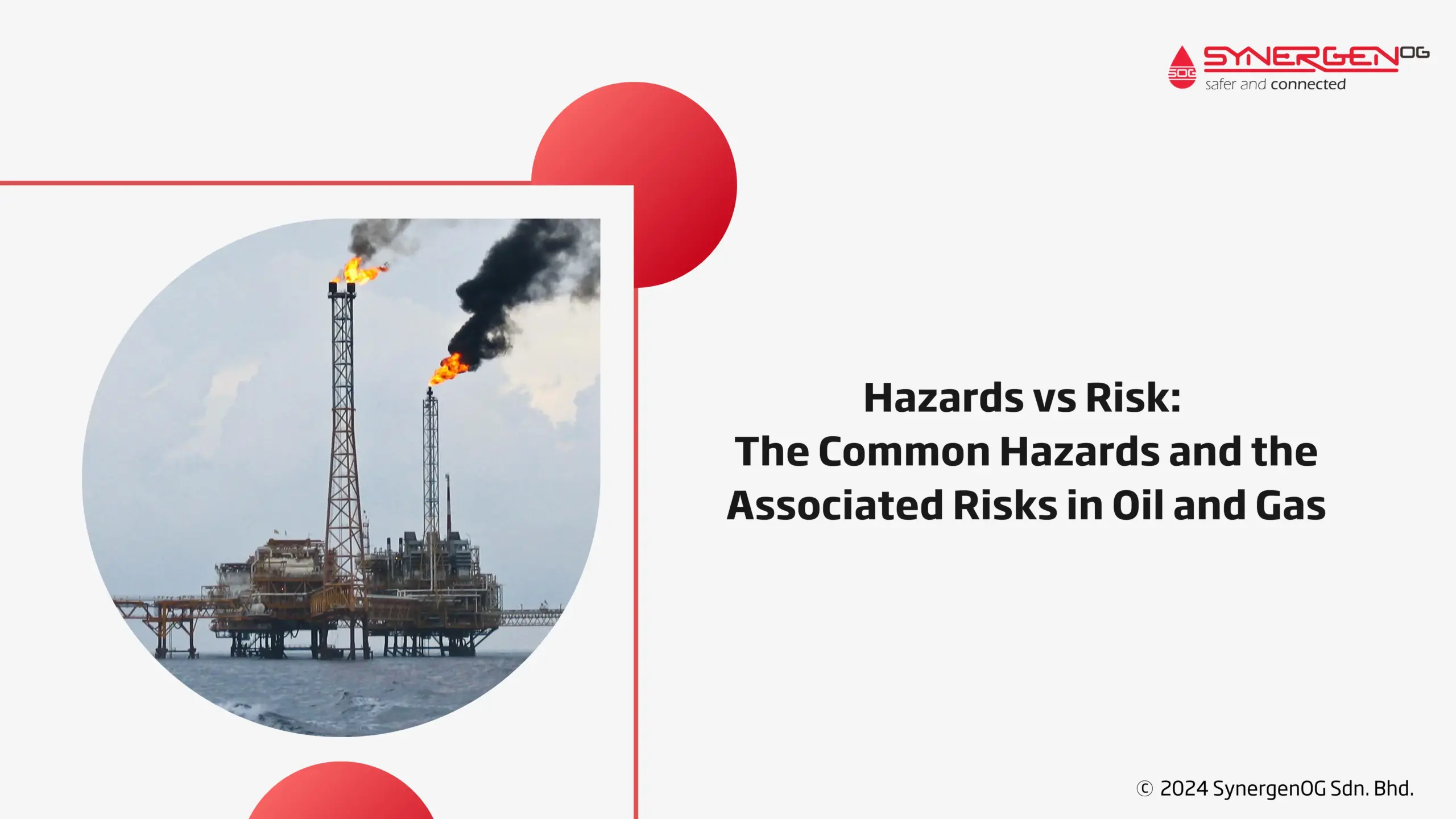

[…] oil industry is inherently complex and high-risk, involving hazardous materials, high pressures, flammable […]
[…] to the nature of operations, the risk profile in gas plants is substantial, demanding meticulous hazard control. Identifying common hazards is essential not only to protect personnel and assets but also to […]
[…] and explosion hazards are among the most serious threats in the oil and gas industry. The presence of flammable hydrocarbons, ignition sources, and high-pressure systems creates […]